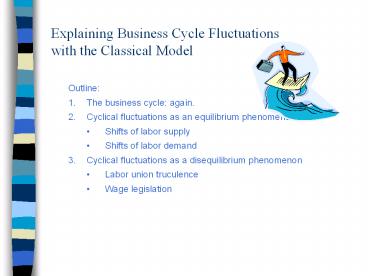Explaining Business Cycle Fluctuations with the Classical Model - PowerPoint PPT Presentation
Title:
Explaining Business Cycle Fluctuations with the Classical Model
Description:
Explaining Business Cycle Fluctuations with the Classical Model Outline: The business cycle: again. Cyclical fluctuations as an equilibrium phenomenon – PowerPoint PPT presentation
Number of Views:48
Avg rating:3.0/5.0
Title: Explaining Business Cycle Fluctuations with the Classical Model
1
Explaining Business Cycle Fluctuations with the
Classical Model
- Outline
- The business cycle again.
- Cyclical fluctuations as an equilibrium
phenomenon - Shifts of labor supply
- Shifts of labor demand
- Cyclical fluctuations as a disequilibrium
phenomenon - Labor union truculence
- Wage legislation
2
Quarterly GDP, 1996 Dollars, Annual Rate
Recessions are shaded
www.economagic.com
3
Employment in Manufacturing Industries, Monthly,
in Thousands
Recessions are shaded
www.economagic.com
4
Housing Starts, Monthly, Annual Rate, in Thousands
Recessions are shaded
www.economagic.com
5
Monthly Consumer Durable Goods Sales, 1996
Dollars, Annual Rate
Recessions are shaded
www.economagic.com
6
Our next slide will illustratea recession that
results from a shift of the labor supply (LS)
schedule. Notice this is an equilibrium situation
in that both actual and potential GDP change.
7
LS2
Real Wage
LS1
B
17
A
15
LD
0
Real GDP
Employment(millions)
100
92
7 Trillion
R
6.5 Trillion
Z
0
Employment(millions)
100
92
8
Some economists believe that fluctuations of real
GDP and employment can be explained by shifts in
the supply of laborbut they are in the minority.
9
Our next slide will illustratea recession that
results from a shift of the labor supply (LD)
schedule. Again notice this is an equilibrium
situation in that both actual and potential GDP
change.
10
LS2
Real Wage
LS1
A
15
13
B
LD1
LD2
0
Real GDP
Employment(millions)
100
92
7 Trillion
R
6.5 Trillion
Z
0
Employment(millions)
100
92
11
Economists of the 1930s viewed the Depression as
a non-market clearing, disequilibrium
phenomenon. That is, frictions in the labor
market were causing the wage to get stuck above
its equilibrium value.
12
Real Wage
Excess Supply
LS1
Wage is stuck at 17
17
A
15
LS
0
Real GDP
Employment(millions)
100
92
108
7 Trillion
R
Now we Have a GDP Gap .5 Trillion
6.5 Trillion
100
0
Employment(millions)
92
13
Why does the labor market fail to clear?
- Firms may have to pay minimum starting wages and
benefits under the terms of collective bargaining
agreements with the UAW, Teamsters, UMW, USW,
UTW, or other major unions. - Federal law stipulates minimum wages and
contributions for social insurance.































